Pontiac Firebird
The Pontiac Firebird is an American automobile that was built by Pontiac from the 1967 to 2002 model years. Designed as a pony car to compete with the Ford Mustang and Mercury Cougar, it was introduced on February 23, 1967, simultaneous with GM's Chevrolet division platform-sharing Camaro.[1] This also coincided with the release of the 1967 Mercury Cougar, Ford's upscale, platform-sharing version of the Mustang.[2][3]
| Pontiac Firebird | |
|---|---|
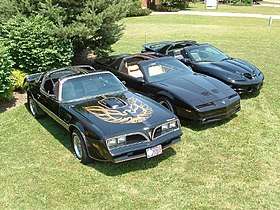 | |
| Overview | |
| Manufacturer | Pontiac (General Motors) |
| Production | February 23, 1967 – August 30, 2002 |
| Body and chassis | |
| Class | Pony car Muscle car |
| Layout | FR layout |
| Platform | F-body |
| Related | Chevrolet Camaro |
| Chronology | |
| Successor | 2004 Pontiac GTO (indirect) |
The name "Firebird" was also previously used by GM for the General Motors Firebird 1950s and early 1960s concept cars.
First generation (1967–1969)
| First generation | |
|---|---|
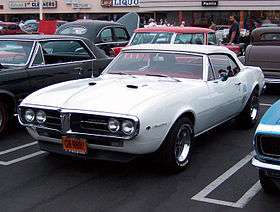 1967 Pontiac Firebird Convertible | |
| Overview | |
| Production | February 23, 1967–1969 |
| Assembly | Lordstown, Ohio, United States (1967–1969) Van Nuys, California, United States (1968–1969) Norwood, Ohio, United States (1969) |
| Body and chassis | |
| Body style | 2-door coupe 2-door convertible |
| Platform | F-body |
| Related | Chevrolet Camaro (first generation) |
| Powertrain | |
| Engine | 230 cu in (3.8 L) Pontiac SOHC I6 250 cu in (4.1 L) Pontiac SOHC I6 326 cu in (5.3 L) Pontiac V8 350 cu in (5.7 L) Pontiac V8 400 cu in (6.6 L) Pontiac V8 |
| Transmission | 2-speed automatic 3-speed Turbo-Hydramatic automatic 3-speed manual 4-speed manual |
| Dimensions | |
| Wheelbase | 108.1 in (2,746 mm) (1967) |
| Length | 188.8 in (4,796 mm) (1967) |
| Width | 72.6 in (1,844 mm) (1967) |
| Height | 51.5 in (1,308 mm) (1967)[4] |
The first generation Firebird had characteristic Coke bottle styling shared with its cousin, the Chevrolet Camaro. Announcing a Pontiac styling trend, the Firebird's bumpers were integrated into the design of the front end, giving it a more streamlined look than the Camaro. The Firebird's rear "slit" taillights were inspired by the 1966–1967 Pontiac GTO. Both a two-door hardtop and a convertible were offered through the 1969 model year. Originally, the car was a "consolation prize" for Pontiac, which had desired to produce a two-seat sports car based on its original Banshee concept car. However, GM feared this would cut into Chevrolet Corvette sales, and gave Pontiac a piece of the "pony car" market through sharing the F-body platform with Chevrolet.
The 1967 base model Firebird came equipped with the Pontiac 230 cu in (3.8 L) SOHC inline-six. Based on the standard Chevrolet 230 cu in (3.8 L) inline-six, it was fitted with a single-barrel carburetor and rated at 165 hp (123 kW).[1] The "Sprint" model six came with a four-barrel carburetor, developing 215 hp (160 kW).[5] Most buyers opted for one of three V8s: the 326 cu in (5.3 L) with a two-barrel carburetor producing 250 hp (186 kW); the four-barrel "HO" (high output) 326, producing 285 hp (213 kW); or the 325 hp (242 kW) 400 cu in (6.6 L) from the GTO. All 1967–1968 400 CI engines had throttle restrictors that blocked the carburetors' second barrels from fully opening.[1] A "Ram Air" option was also available, providing functional hood scoops, higher flow heads with stronger valve springs, and a hotter camshaft. Power for the Ram Air package was the same as the conventional 400 HO, but peaked at 5,200 rpm.
The 230 cu in (3.8 L) engines were subsequently replaced in 1968 by the Chevrolet 250 cu in (4.1 L) stroked 230 cu in (3.8 L) engines, the first developing an increased 175 hp (130 kW) using a single-barrel carburetor, and the other the same 215 hp with a four-barrel carburetor. Also for the 1968 model, the 326 cu in (5.3 L) engine was replaced by the Pontiac 350 cu in (5.7 L) V8, which actually displaced 355 cu in (5.8 L), and produced 265 hp (198 kW) with a two-barrel carburetor. An HO version of the 350 cu in (5.7 L) with a revised cam was also offered starting in that year, which developed 320 hp (239 kW). Power output of the other engines was increased marginally.[1]
There was an additional Ram Air IV option for the 400 cu in (6.6 L) V8 engines during 1969, complementing the Ram Air III; these generated 345 hp (350 PS; 257 kW) at 5000 rpm and 430 lb⋅ft (583 N⋅m) of torque at 3400 rpm;[6] and 335 hp (340 PS; 250 kW) respectively. The 350 cu in (5.7 L) HO engine was revised again with a different cam and cylinder heads resulting in 325 hp (242 kW). During 1969 a special 303 cu in (5.0 L) engine was designed for SCCA road racing applications that was not available in production cars.[7]
The styling difference from the 1967 to the 1968 model was the addition of federally-mandated side marker lights: for the front of the car, the turn signals were made larger and extended to wrap around the front edges of the car, and on the rear, the Pontiac (V-shaped) Arrowhead logo was added to each side. The front door vent-windows were replaced with a single pane of glass and Astro Ventilation, a fresh-air-inlet system. The 1969 model received a major facelift with a new front end design but unlike the GTO, it did not have the Endura bumper. The instrument panel and steering wheel were revised. The ignition switch was moved from the dashboard to the steering column with the introduction of GM's new locking ignition switch/steering wheel.[1]
In March 1969, a $1,083[8] optional handling package called the "Trans Am performance and appearance package", UPC "WS4", named after the Trans Am Series, was introduced. A total of 689 hardtops and eight convertibles were made.[1]
Due to engineering problems that delayed the introduction of the all-new 1970 Firebird beyond the usual fall debut, Pontiac continued production of 1969 model Firebirds into the early months of the 1970 model year (the other 1970 Pontiac models had been introduced on September 18, 1969). By late spring of 1969, Pontiac had deleted all model-year references on Firebird literature and promotional materials, anticipating the extended production run of the then-current 1969 models.
| Model | 1967[9] | 1968 | 1969 |
|---|---|---|---|
| Two-door hardtop coupe | 67,032 | 90,152 | 75,362 |
| Two-door convertible | 15,528 | 16,960 | 11,649 |
| Two-door coupe Trans Am | 689 | ||
| Two-door convertible Trans Am | 8 | ||
| Total | 82,560 | 107,112 | 87,708 |
Engines
| 1967 | Std 230 cu in (3.8 L) Pontiac SOHC I6 165 hp (123 kW) | W53 "Sprint" 230 CID Pontiac SOHC I6 215 hp (160 kW) | L30 326 cu in (5.3 L) Pontiac V8 250 hp (186 kW) | L76 326 CID Pontiac "H.O." V8 285 hp (213 kW) | W66 400 cu in (6.6 L) Pontiac V8 325 hp (242 kW) | L67 400 CID Pontiac Ram Air V8 325 hp (242 kW) | ||
| 1968 | Std 250 cu in (4.1 L) Pontiac SOHC I6 175 hp (130 kW) | W53 "Sprint" 250CID Pontiac SOHC I6 215 hp (160 kW) | L30 350 cu in (5.7 L) Pontiac V8 265 hp (198 kW) | L76 350 CID Pontiac "H.O." V8 320 hp (239 kW) | W66 400 CID Pontiac V8 330 hp (246 kW) | L67 400 CID Pontiac Ram Air V8 335 hp (250 kW) | L74 400 CID Pontiac "H.O." V8 335 hp (250 kW) | L67 400 CID Pontiac Ram Air II V8 340 hp (254 kW)[a 1] |
| 1969 | Std 250 CID Pontiac SOHC I6 175 hp | W53 "Sprint" 250 CID Pontiac SOHC I6 230 hp (172 kW) | L30 350 CID Pontiac V8 265 hp (198 kW) | L76 350 CID Pontiac "H.O." V8 325 hp (242 kW) | W66 400 CID Pontiac V8 330 hp (246 kW) | L74 400 CID Pontiac "H.O." Ram Air III V8 335 hp (250 kW) | L67 400 CID Pontiac Ram Air IV V8 345 hp (257 kW) |
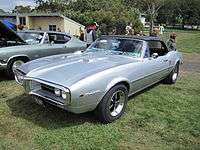 1967 Pontiac Firebird 400 convertible
1967 Pontiac Firebird 400 convertible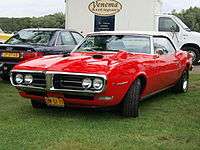 1968 Pontiac Firebird convertible 400 Ram Air with the optional "hood tach"
1968 Pontiac Firebird convertible 400 Ram Air with the optional "hood tach" 1969 Pontiac Firebird Trans Am
1969 Pontiac Firebird Trans Am
Second generation (1970–1981)
| Second generation | |
|---|---|
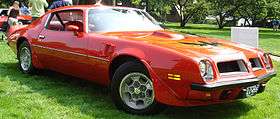 1974 Firebird | |
| Overview | |
| Production | 1970–1981 |
| Assembly | Van Nuys, California, United States (1970–1971, 1978–1981) Norwood, Ohio, United States (1970–1981) |
| Body and chassis | |
| Body style | 2-door coupe |
| Platform | F-body |
| Related | Chevrolet Camaro (second generation) |
| Powertrain | |
| Engine | 231 cu in (3.8 L) Buick V6 250 cu in (4.1 L) Chevrolet I6 265 cu in (4.3 L) Pontiac V8 301 cu in (4.9 L) Pontiac V8 301 cu in (4.9 L) Pontiac turbo V8 305 cu in (5.0 L) Chevrolet LG3 V8 305 cu in (5.0 L) Chevrolet LG4 V8 350 cu in (5.7 L) Buick V8[a 2] 350 cu in (5.7 L) Oldsmobile V8[a 2] 350 cu in (5.7 L) Chevrolet V8[a 2] 350 cu in (5.7 L) Pontiac V8 400 cu in (6.6 L) Pontiac V8 403 cu in (6.6 L) Oldsmobile V8 455 cu in (7.5 L) Pontiac V8 |
| Transmission | 3-speed manual 4-speed manual 2-speed automatic 3-speed automatic |
| Dimensions | |
| Wheelbase | 108.2 in (2,748 mm) (1978)[10] |
| Length | 196.8 in (4,999 mm) (1978) |
| Width | 73.4 in (1,864 mm) (1978) |
| Height | 49.3 in (1,252 mm) (1978) |
The second generation debut for the 1970 model year was delayed until February 26, 1970, because of tooling and engineering problems; thus, its popular designation as a 1970½ model, while leftover 1969s were listed in early Pontiac literature without a model-year identification.[11] This generation of Firebirds were available in coupe form only; after the 1969 model year, convertibles were not available until 1989.
Models
- Firebird Base
- Firebird Esprit
- Firebird Formula
- Firebird Trans-Am
Special versions and appearance packages
- Formula Appearance Package "W50" (1976–1981)[1]
- Black-and-Gold Trans Am Pontiac 50th Anniversary Limited Edition (1976)[1]
- Black-and-Gold Trans Am Special Edition (1977–1978, 1980–1981)[1]
- Sky Bird Esprit Appearance Package "W60" (1977–1978)[1]
- Gold Trans Am Special Edition "Y88" (1978)[1]
- Red Bird Esprit Appearance Package "W68" (1978–1979)[1]
- Black Trans Am Special Edition "Y84" (1979)[1]
- Trans Am 10th Anniversary Edition (1979)[1]
- Yellow Bird Esprit Appearance Package "W73" (1980)[1]
- Trans Am Turbo Indy Pace Car Edition (1980)[1]
- Trans Am Turbo NASCAR Pace Car Edition (1981)[12]
- Macho Trans-Am (a package offered by the Mecham Pontiac dealership in Glendale, AZ).[13]
Replacing the "Coke bottle" styling was a more "swoopy" body style, while still retaining some traditional elements. The top of the rear window line going almost straight down to the lip of the trunk lid, a look that was to epitomize F-body styling for the longest period during the Firebird's lifetime. The new design was initially characterized with a large B-pillar, until 1975 when the rear window was enlarged.
1970
There were two Ram Air 400 cu in (6.6 L) engines for 1970: the 335 hp (250 kW) L74 Ram Air III (366 hp (273 kW) in GTO) and the 345 hp (257 kW) LS1 Ram Air IV (370 hp (280 kW) in GTO) that were carried over from 1969. The difference between the GTO and Firebird engines was that the secondary carburetor's throttle linkage had a restrictor which prevented the rear barrels from opening completely,[1] adjusting the linkage could allow full carburetor operation resulting in identical engine performance.
For the 1970 and 1971 model years, all Firebirds equipped with radios had the antennas mounted "in-glass" in the windshield.[1]
| Model | No. |
|---|---|
| 2-door base 6-cylinder | 3,184 |
| 2-door base 8-cylinder | 15,740 |
| 2-door Esprit 8-cylinder | 18,961 |
| 2-door Formula 400 8-cylinder | 7,708 |
| 2-door Trans Am Ram Air III 8-cylinder | 3,108 |
| 2-door Trans Am Ram Air IV 8-cylinder | 88 |
| Total | 48,739 |
1971
.jpg)
The Pontiac 455 cu in (7.5 L) engine first became available in the second generation Firebird in 1971. The 455 engine was available in the L75 325 hp (242 kW) version and the LS5 335 hp HO version, which was the standard, and only engine option, for the Trans Am. The HO engine also included Ram Air IV.[1]
| Model | No. |
|---|---|
| 2-door base 6-cylinder | 2,975 |
| 2-door base 8-cylinder | 20,047 |
| 2-door Esprit 8-cylinder | 20,185 |
| 2-door Formula 400 8-cylinder | 7,802 |
| 2-door Trans Am Ram 8-cylinder | 2,116 |
| Total | 53,125 |
1972
During a 1972 strike, the Firebird (and the similar F-body Camaro) were nearly dropped.[14]
Again the 455HO was the only engine available for the Trans Am.[1]
Starting in 1972, and continuing until 1977, the Firebird was only produced at the Norwood, Ohio, facility.[1]
| Model | No. |
|---|---|
| 2-door base | 12,001 |
| 2-door Esprit | 11,415 |
| 2-door Formula | 5,249 |
| 2-door Trans Am | 1,286 |
| Total | 29,951 |
1973
Actual production cars yielded 1/4 mile results in the high 14 to 15.0 second/98 mph range (sources: Motor Trend Magazine, July '73 and Roger Huntington's book, American Supercar) – results that are consistent with a 3,850 pound car (plus driver) and the engine equipped with a 4-barrel Rochester Quadrajet carburetor rated at a maximum power of 290 bhp (294 PS; 216 kW) at 4000 rpm and a maximum torque of 395 lb⋅ft (536 N⋅m) at 3600 rpm figure.[15] An original rating of 310 bhp (314 PS; 231 kW) SAE net had been assigned to the SD-455, though that rating was based on the emissions non-compliant "pre-production" engines, as mentioned above. That rating appeared in published 1973 model year Pontiac literature, which had been printed prior to the "pre-production" engines "barely passing" emissions testing, and the last minute switch to what became the production engine. The 1974 model year production literature listed the specifications of the production engine (290 SAE net horsepower).
In 1973 and 1974, a special version of the 455, called the Super Duty 455 (SD-455), was offered. The SD-455 consisted of a strengthened cylinder block that included four-bolt main bearings and added material in various locations for improved strength. Original plans called for a forged crankshaft, although actual production SD455s received nodular iron crankshafts with minor enhancements. Forged rods and forged aluminum pistons were specified, as were unique high-flow cylinder heads.
The 480737 code cam (identical grind to the RAIV "041" cam) was originally specified for the SD455 engine and was fitted into the "pre-production" test cars (source: former Pontiac special projects engineer McCully), one of which was tested by both Hot Rod and Car and Driver magazines. However, actual production cars were fitted with the milder 493323 cam and 1.5:1 rocker ratios, due to the ever-tightening emissions standards of the era. This cam and rocker combination, combined with a low compression ratio of 8.4:1 advertised (7.9:1 actual) yielded 290 SAE net horsepower. Production SD455 cars did not have functional hood scoops, while the "pre-production" test cars did.
A production line stock SD455 produced 253 rear wheel HP on a chassis dyno, as reported by High Performance Pontiac magazine (January, 2007). This is also consistent with the 290 SAE net horsepower factory rating (as measured at the crankshaft). Skip McCully verified that no production SD455s released to the public were fitted with the 480737 cam. When asked about the compromises for the production SD455 engine, McCully responded, "Compression, camshaft, jetting, and vacuum advance." He followed by stating that he would have preferred a compression ratio of 10.25:1, a camshaft with 041 valve timing, slightly richer carburetor jetting, and as much vacuum advance as the engine would tolerate. However, that proved to be impossible due to the emissions regulations of the era. Overlooked however, is a June 1974 test of a newly delivered, privately owned SD-455 Trans Am. This appeared in Super Stock and Drag Illustrated. With an unmodified car and a test weight of 4,010 lbs the testers clocked 14.25 seconds at 101 mph. The car had automatic and A/C.[16] Also, the factory rating of 290 hp was listed at 4,400 rpm while the factory tachometer has a 5,750 rpm redline.
Pontiac offered the 455 through the 1976 model year, but the engine could not meet tightening restrictions on vehicle emissions. A total of 7,100 were produced with the 455 engine.
| Model | No. |
|---|---|
| 2-door base 6- & 8-cylinder | 14,096 |
| 2-door Esprit 8-cylinder | 17,249 |
| 2-door Formula 8-cylinder | 10,123 |
| 2-door Formula SD 455 8-cylinder | 43 |
| 2-door Trans Am 8-cylinder | 4,550 |
| 2-door Trans Am SD 455 8-cylinder | 252 |
| Total | 46,313 |
1974
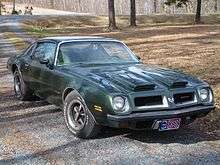
Curb weights rose dramatically in the 1974 model year due to the implementation of 5 mph (8.0 km/h) telescoping bumpers and various other crash and safety related structural enhancements; SD455 Trans Ams weighed in at 3,850 lb (1,746 kg) in their first year of production (1974 model year; actually 1973).
The 1974 models featured a redesigned "shovel-nose" front end and new wide "slotted" taillights. In 1974, Pontiac offered two base engines for the Firebird: a 100 hp (75 kW) 250 cu in (4.1 L) inline-6 and a 155 hp (116 kW) 350 cu in (5.7 L) V8. Available were 175 to 225 hp (130 to 168 kW) 400 cu in (6.6 L) V8 engines, as well as the 455 cu in (7.5 L) produced 215 or 250 hp (160 or 186 kW), while the SD-455 produced 290 hp (216 kW). The 400, 455, and SD-455 engines were offered in the Trans Am and Formula models during 1974.
A 1974 Firebird was driven by Jim Rockford in the pilot movie and the first season (1974–1975) of The Rockford Files, and every following season, Rockford would change to the next model year. However, in the sixth season (1979–1980), Rockford continued to drive the 1978 Firebird from season five, as James Garner disliked the 1979 model's restyled front end. The cars in the show were badged as lower-tier Esprit models, but in reality were Formulas with the twin-scoop hood replaced with a scoopless one. Another hint was the twin exhausts and rear anti-roll bars that were not used on Esprit.
| Model | No. |
|---|---|
| 2-door base 6-cylinder | 7,603 |
| 2-door base 8-cylinder | 18,769 |
| 2-door Esprit 8-cylinder | 22,583 |
| 2-door Formula 8-cylinder | 14,461 |
| 2-door Formula SD 455 8-cylinder | 58 |
| 2-door Trans Am with 400ci 8-cylinder | 4,664 |
| 2-door Trans Am with 455ci 8-cylinder | 4,648 |
| 2-door Trans Am SD 455 8-cylinder | 943 |
| Total | 73,729 |
1975
The 1975 models featured a new wraparound rear window with a revised roofline and the turn signals were moved up from the valance panel to the grills which distinguished it from the previous year model. The Super Duty engine, Muncie four-speed, and TurboHydramatic 400 automatic were no longer available in 1975. Due to the use of catalytic converters starting in 1975, the THM 400 would not fit alongside the catalytic converter underneath the vehicle. The smaller TurboHydramatic 350 automatic was deemed enough. The 400 was standard in the Trans Am and the 455 was optional for both 1975 and 1976 models.
| Model | No. |
|---|---|
| 2-door base 6- & 8-cylinder | 22,293 |
| 2-door Esprit 6- & 8-cylinder | 20,826 |
| 2-door Formula 8-cylinder | 13,670 |
| 2-door Trans Am with 400ci 8-cylinder | 26,417 |
| 2-door Trans Am with 455ci 8-cylinder | 857 |
| Total | 84,063 |
1976
Pontiac celebrated its 50th anniversary year in 1976.[17] To commemorate this event, Pontiac unveiled a special Trans Am option at the 1976 Chicago Auto Show.[18] Painted in black with gold accents, this was the first "anniversary" Trans Am package and the first production black and gold special edition. A removable T-top developed by Hurst was optional, but proved problematic.[18] This was the last year with the 455 engine
| Model | No. |
|---|---|
| 2-door base 6- & 8-cylinder | 21,206 |
| 2-door Esprit 6- & 8-cylinder | 22,252 |
| 2-door Formula 8-cylinder | 20,613 |
| 2-door Trans Am with 400ci 8-cylinder | 37,015 |
| 2-door Trans Am with 455ci 8-cylinder | 7,099 |
| 2-door Trans Am with 400ci 8-cylinder limited edition |
1,628 |
| 2-door Trans Am with 455ci 8-cylinder limited edition |
319 |
| 2-door Trans Am with 400ci 8-cylinder limited edition with T-top |
533 |
| 2-door Trans Am with 455ci 8-cylinder limited edition with T-top |
110 |
| Total | 110,775 |
1977
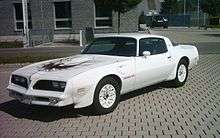
A distinctive, slant-nose facelift occurred in 1977. There is a way to tell an early 1977 built car as there was a production change in the hood scoop. Early cars were supplied with an off-center scoop. Furthermore, early W72 cars came with the standard 180 hp air cleaner. Pontiac offered the T/A 400 cu in (6.6 L) with a single 4-barrel Rochester Quadrajet carburetor RPO W72 rated at 200 bhp (203 PS; 149 kW) at 3600 rpm and a maximum torque of 325 lb⋅ft (441 N⋅m) at 2400 rpm, as opposed to the regular 6.6 Litre 400 (RPO L78) rated at 180 hp (134 kW). The T/A 6.6 equipped engines had chrome valve covers, while the base 400 engines had painted valve covers. In addition, California and high-altitude cars received the Olds 403 engine, which offered a slightly higher compression ratio and a more usable torque band than the Pontiac engines of 1977.
From 1977 to 1981, the Firebird used four square headlamps, while the Camaro continued to retain the two round headlights that had been shared by both second generation designs. The 1977 Trans-Am Special Edition became famous after being featured in Smokey and the Bandit. The 1980 Turbo model was used for Smokey and the Bandit II.
| Model | No. |
|---|---|
| 2-door base 6- & 8-cylinder | 30,642 |
| 2-door Esprit 6- & 8-cylinder | 34,548 |
| 2-door Formula 8-cylinder | 21,801 |
| 2-door Trans Am w/400ci L78 8-cylinder | 29,313 |
| 2-door Trans Am w/400ci W72 8-cylinder | 18,785 |
| 2-door Trans Am w/403ci L80 8-cylinder | 5,079 |
| 2-door Trans Am w/400ci L78 8-cylinder Special Edition |
748 |
| 2-door Trans Am w/400ci W72 8-cylinder Special Edition |
933 |
| 2-door Trans Am w/403ci L80 8-cylinder Special Edition |
180 |
| 2-door Trans Am w/400ci L78 8-cylinder Special Edition w/T-top |
6,030 |
| 2-door Trans Am w/400ci W72 8-cylinder Special Edition w/T-top |
6,459 |
| 2-door Trans Am w/403ci L80 8-cylinder Special Edition w/T-top |
1,217 |
| Total | 155,735 |
1978
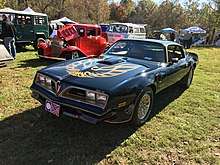
Changes for 1978 were slight, with a switch from a honeycomb to a crosshatch pattern grille being the most obvious from the outside.[19] Beginning in 1978, the Pontiac group introduced a new special edition vehicle. The Firebird Formula LT Sport Edition which featured a revised 10% raised compression Chevy 305 V8 powertrain producing 155 hp (same as 1977 Chevy Monza Mirage) combined with a floor center console four-speed manual T-10 BW transmission coupled to a limited-slip differential final drive. The limited touring package (LT) also included a cabin roof, door, fender and hood graphics scheme, the Trans-Am sports handling package with HD gas shocks, modular alloy wheels and the SE Trans-Am rear deck spoiler with "Formula" word graphic detail. T-tops in 1978 transitioned from Hurst units to Fisher (GM) in mid year. In 1978 Pontiac also made available the Red Bird package on the Firebird Esprit model. Painted in Roman Red with a matching red interior it had a Gold pinstripe treatment with Red Bird graphics on the b-pillars. It also utilized the Trans-Am style steering wheel and dash except these were finished with gold spokes and a gold dash face which was unique to the Red Bird option.
The engineers also revised the compression ratio in the 400ci through the installation of different cylinder heads with smaller combustion chambers (1977 Pontiac 400 engines also had the 350 heads bolted to the 400 blocks, these heads were known as the 6x-4 heads and were taken from the Pontiac 350). This increased power by 10% for a total of 220 during the 1978–79 model years. The 400/403 options remained available until 1979, when the 400 CID engines were only available in the 4-speed transmission Trans Ams and Formulas (the engines had actually been stockpiled from 1978, when PMD had cut production of the engine).
| Model | No. |
|---|---|
| 2-door base 6- & 8-cylinder | 32,671 |
| 2-door Esprit 6- & 8-cylinder | 36,926 |
| 2-door Formula 8-cylinder | 24,346 |
| 2-door Trans Am w/400ci L78 8-cylinder | 63,812 |
| 2-door Trans Am w/400ci W72 8-cylinder | 8,251 |
| 2-door Trans Am w/403ci L80 8-cylinder | 8,969 |
| 2-door Trans Am w/400ci L78 8-cylinder Black Special Edition |
3,433 |
| 2-door Trans Am w/403ci L80 8-cylinder Black Special Edition |
210 |
| 2-door Trans Am w/400ci L78'- 8-cylinder Gold Special Edition |
7,796 |
| 2-door Trans Am w/403ci L80 8-cylinder Gold Special Edition |
880 |
| Total | 187,294 |
1979
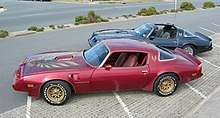
The front end was restyled for 1979, which also marked the 10th anniversary of the Trans Am. A limited edition anniversary package was made available: platinum silver paint with charcoal gray upper paint accents and mirrored t-tops, and a special interior featuring silver leather seats with custom-embroidered Firebird emblems and aircraft-inspired red lighting for the gauges. The 10th anniversary cars also featured a special 10th anniversary decals, including a Firebird hood decal that extended off of the hood and onto the front fenders. Pontiac produced 7,500 10th anniversary cars, of which 1,817 were equipped with the high-output Pontiac T/A 6.6 W72 400 engine, the last of the line of the Pontiac 'big-block' V8 motors (and coupled with the four-speed Borg Warner Super T-10 manual transmission). The only option on these cars was the engine (the 400 was not certified for California, nor was cruise control available with it), which dictated the transmission and the gear ratio (3.23 on the 400 cars, 2.73 on the cars with the Oldsmobile-produced 403 engine and the TH350 automatic transmission). Two 10th Anniversary Trans Ams were the actual pace cars for the 1979 Daytona 500, which has been called the race that made NASCAR. Car and Driver magazine named the Trans Am with the WS6 performance package the best handling car of 1979. During period dyno testing, the National Hot Rod Association rated the limited-availability T/A 6.6 high-output Pontiac 400 engine at 260–280 net horsepower, which was significantly higher than Pontiac's conservative rating of 220 hp. In 1979 Pontiac sold 116,535 Trans Ams, the highest sold in a year.
| Model | No. |
|---|---|
| 2-door base 6- & 8-cylinder | 38,642 |
| 2-door Esprit 6- & 8-cylinder | 30,853 |
| 2-door Formula 8-cylinder | 24,850 |
| 2-door Trans Am w/301ci 8-cylinder | 8,605 |
| 2-door Trans Am w/400ci 8-cylinder | 2,485 |
| 2-door Trans Am w/403ci 8-cylinder | 48,488 |
| 2-door Trans Am w/301ci 8-cylinder w/T-tops | 4,831 |
| 2-door Trans Am w/400ci 8-cylinder w/T-tops | 2,917 |
| 2-door Trans Am w/403ci 8-cylinder w/T-tops | 30,728 |
| 2-door Trans Am w/301ci 8-cylinder Special Edition w/T-tops |
573 |
| 2-door Trans Am w/400ci 8-cylinder Special Edition w/T-tops |
1,107 |
| 2-door Trans Am w/403ci 8-cylinder Special Edition w/T-tops |
9,874 |
| 2-door Trans Am w/400ci 8-cylinder 10th Anniversary Edition |
1,817 |
| 2-door Trans Am w/403ci 8-cylinder 10th Anniversary Edition |
5,683 |
| Total | 211,453 |
1980
In 1980, due to ever-increasing emissions restrictions, Pontiac dropped all of its large displacement engines.[20] 1980 therefore saw the biggest engine changes for the Trans Am. The 301, offered in 1979 as a credit option, was now the standard engine. Options included a turbocharged 301 or the Chevrolet 305 small block. The turbocharged 301 used a Garrett TB305 turbo forcing air through a single Rochester Quadrajet 4-barrel carburetor, which was, however, too antiquated to take full advantage of the forced air from the turbo. Also, the low-octane (87–90) fuels would have led to severe detonation, had it not been for the ECU, which led to the cars feeling not very powerful at all. Some owners have claimed quite reasonable performance numbers with the modern fuels though.[21][22]
A 1980 Turbo Trans Am was featured in Smokey and the Bandit II. However, due to the turbocharger problems, the cars used for the filming had to be fitted with nitrous oxide tanks by Marvin Miller Systems to get the desired performance.[23]
| Model | No. |
|---|---|
| 2-door base 6- & 8-cylinder | 29,811 |
| 2-door Esprit 6- & 8-cylinder | 17,277 |
| 2-door Formula 8-cylinder | 9,356 |
| 2-door Trans Am w/4.9L 8-cylinder | 25,714 |
| 2-door Trans Am w/4.9L Turbo 8-cylinder | 16,476 |
| 2-door Trans Am w/5.0L 8-cylinder | 3,006 |
| 2-door Trans Am Turbo Indy Pace Car 8-cylinder | 5,700 |
| Total | 107,340 |
1981
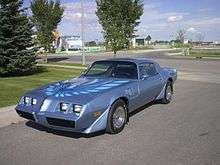
In the final year of the second generation Firebirds (1981), Trans Am still used the same engines as it had in the previous model year, with the only change being the addition of a new electronic carburetion system.
The assembly plant code for Norwood, OH is "N" (from 1972 to 1980 this would be the fifth VIN digit, for 1981 it is the 11th digit), and for Van Nuys, CA it is "L" (for Los Angeles, of which Van Nuys, Los Angeles is a district). In the later second-generation cars, Norwood used lacquer-based paint (there is an "L" on the cowl tag), and Van Nuys used water-based paint (there is a "W" on the cowl tag), due to California's tightening pollution regulations. The water-based paint often failed and delaminated during the warranty period and subsequently, cars had to be repainted.
| Model | No. |
|---|---|
| 2-door base 6- & 8-cylinder | 20,541 |
| 2-door Esprit 6- & 8-cylinder | 10,938 |
| 2-door Formula 8-cylinder | 5,927 |
| 2-door Trans Am w/4.9L E/C 8-cylinder | 10,877 |
| 2-door Trans Am w/4.9L Turbo 8-cylinder | 13,578 |
| 2-door Trans Am w/5.0L 8-cylinder | 7,038 |
| 2-door Trans Am NASCAR Turbo Pace Car 8-cylinder | 2,000 |
| Total | 70,899 |
Engines
| 1970 | Std 250 cu in (4.1 L) Chevrolet I6 155 hp (116 kW) | Esprit std 350 cu in (5.7 L) Pontiac V8 255 hp (190 kW) | 346 400 cu in (6.6 L) Pontiac V8 265 hp (198 kW) | L78 400 CID Pontiac V8 330 hp (246 kW) | L74 400 CID Pontiac Ram Air III V8 345 hp (257 kW) | 400 CID Pontiac Ram Air IV V8 370 hp (276 kW) | L74 (T/A std) 400 CID Pontiac Ram Air IV V8 335 hp (250 kW) | LS1 400 CID Pontiac Ram Air IV V8 345 hp (257 kW) |
| 1971 | Std 250 CID Chevrolet I6 155 hp (bhp)[a 3] 110 hp (82 kW) (whp) | L30 350 CID Pontiac V8 250 hp (186 kW) (bhp) 165 hp (123 kW) (whp) | L65 400 CID Pontiac V8 265 hp (bhp) 180 hp (134 kW) (whp) | L78 400 CID Pontiac V8 300 hp (224 kW) (bhp) 250 hp (186 kW) (whp) | L75 455 cu in (7.5 L) Pontiac V8 325 hp (242 kW) (bhp) 255 hp (whp) | LS5 455 CID Pontiac "H.O." Ram Air IV V8 335 hp (bhp) 305 hp (227 kW) (whp) | ||
| 1972 | Std 250 CID Chevrolet I6 110 hp | L30 350 CID Pontiac V8 175 hp (130 kW) | L65 400 CID Pontiac V8 200 hp (149 kW) | L78 400 CID Pontiac V8 250 hp (186 kW) | LS5 455 CID Pontiac "H.O." V8 300 hp (224 kW) | |||
| 1973 | Std 250 CID Chevrolet I6 100 hp (75 kW) | L30 350 CID Pontiac V8 150–175 hp (112–130 kW)[a 4] | L65 400 CID Pontiac V8 170–185 hp (127–138 kW)[a 4] | L78 400 CID Pontiac V8 230 hp (172 kW) | L75 455 CID Pontiac V8 250 hp (186 kW) | LS2 455 CID Pontiac "SD" V8 290–310 hp (216–231 kW)[a 5] | ||
| 1974 | Std 250 CID Chevrolet I6 100 hp | L30 350 CID Pontiac V8 155–170 hp (116–127 kW)[a 6] | L65 400 CID Pontiac V8 190 hp (142 kW) | L78 400 CID Pontiac V8 200 hp (149 kW) | L75 455 CID Pontiac V8 250 hp (186 kW) | LS2 455 CID Pontiac "SD" V8 290 hp (216 kW) | ||
| 1975 | L22 250 CID Chevrolet I6 100 hp | L30 350 CID Pontiac V8 155 hp (116 kW) | L76 350 CID Pontiac V8 175 hp (130 kW) | L78 400 CID Pontiac V8 185 hp (138 kW) | L75 455 CID Pontiac "H.O." V8 [a 7]200 hp (149 kW) | |||
| 1976 | L22 250 CID Chevrolet I6 100 hp | L30 350 CID Pontiac V8 160 hp (119 kW) | L76 350 CID Pontiac V8 165 hp (123 kW) | L78 400 CID Pontiac V8 185 hp (138 kW) | L75 455 CID Pontiac "H.O." V8 200 hp (149 kW) | |||
| 1977 | LD 231 cu in (3.8 L) Buick V6 105 hp (78 kW) | L27 301 cu in (4.9 L) Pontiac V8 135 hp (101 kW) | L34 350 CID Pontiac V8 170 hp (127 kW) | L76 350 CID Oldsmobile V8 170 hp (127 kW) | L78 400 CID Pontiac V8 180 hp (134 kW) | W72 400 CID Pontiac V8 200 hp (149 kW) | L80 403 cu in (6.6 L) Oldsmobile V8 185 hp (138 kW) | |
| 1978 | LD5 3.8 L (231 cu in) Buick V6[a 8] 105 hp | LG3 5.0 L (305 cu in) 5.0L Chevrolet V8 135 hp (101 kW) | LM1 5.7 L (350 cu in) V8[a 2] 170 hp (127 kW) | L78 6.6 L (400 cu in) Pontiac V8 185 hp (138 kW) | W72 6.6L Pontiac V8 220 hp (164 kW) | L80 6.6 L (403 cu in) Oldsmobile V8 185 hp (138 kW) | ||
| 1979 | LD5 3.8L Buick V6 105 hp | L27 4.9 L (301 cu in) Pontiac V8 135 hp (101 kW) | L37 4.9L Pontiac V8 150 hp (112 kW) | LG3 5.0L Chevrolet V8 135 or 150 hp (101 or 112 kW) | LM1 5.7L Chevrolet V8 170 hp (127 kW) | W72 6.6L Pontiac V8 220 hp (164 kW) | L80 6.6L Oldsmobile V8 185 hp (138 kW) | |
| 1980 | LD5 3.8L Buick V6 105 hp | L37 4.9L Pontiac V8 140 hp (104 kW) | W72 4.9L Pontiac E/C V8 155 hp (116 kW) | LU8 4.9L Pontiac Turbo V8 210 hp (157 kW) | LG4 5.0L Chevrolet V8 150 hp (112 kW) | |||
| 1981 | LD5 3.8L Buick V6 | LS5 4.3 L (265 cu in) Pontiac V8 140 hp (104 kW) | L37 4.9L Pontiac E/C V8 155 hp (116 kW) | LU8 4.9L Pontiac Turbo V8 200 hp (149 kW) | LG4 5.0L Chevrolet V8 150 hp (112 kW) |
Third generation (1982–1992)
| Third generation | |
|---|---|
 1989 20th Anniversary Turbo Trans Am convertible | |
| Overview | |
| Production | 1982–1992 |
| Assembly | Van Nuys, California, United States Norwood, Ohio, United States (1982–1987) |
| Body and chassis | |
| Body style | 2-door liftback 2-door convertible |
| Platform | F-body |
| Related | Chevrolet Camaro (third generation) |
| Powertrain | |
| Engine | 151 cu in (2.5 L) Pontiac I4 173 cu in (2.8 L) GM 60° V6 191 cu in (3.1 L) GM 60° V6 231 cu in (3.8 L) Buick Turbo V6 305 cu in (5.0 L) Chevrolet V8 350 cu in (5.7 L) Chevrolet V8 |
| Transmission | 3-speed automatic 4-speed automatic 4-speed manual 5-speed manual |
| Dimensions | |
| Wheelbase | 101 in (2,565 mm) |
| Length | 1990–92 Firebird: 195.1 in (4,956 mm) 1990–92 Trans Am: 195.2 in (4,958 mm) Pre-1988 Firebird: 190.5 in (4,839 mm) Pre-1988 Trans Am: 191.8 in (4,872 mm) |
| Width | 72.4 in (1,839 mm) |
| Height | 49.7 in (1,262 mm) |
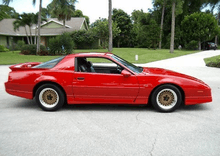
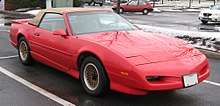
The availability and cost of gasoline (two fuel crises had occurred by this time) meant the weight and the fuel consumption of the 3rd generation had to be considered in the design. In F-body development, both the third generation Firebird and Camaro were proposed as possible front wheel drive platforms, but the idea was scrapped. Computerized engine management was in its infancy, and with fuel efficiency being the primary objective, it was not possible to have high horsepower and torque numbers. They did manage to cut enough weight from the design so that acceleration performance would be better than the 1981 models. They also succeeded in reducing fuel consumption, offering a four-cylinder Firebird that would provide 34 miles per US gallon (6.9 l/100 km).[24] GM executives decided that engineering effort would best be spent on aerodynamics and chassis development. They created a modern platform, so that when engine technology advanced, they would have a well-balanced package with acceleration, braking, handling, and aerodynamics. For the time being, they would have world class aerodynamics and handling, and excellent fuel economy.
The Firebird and Camaro were completely redesigned for the 1982 model year, with the windshield slope set at 62 degrees, (about three degrees steeper than anything GM had ever tried before), and for the first time, a large, glass-dominated hatchback that required no metal structure to support it. Two concealed pop-up headlights, a first on the F-Body cars, were the primary characteristic that distinguished the third generation Firebird from both its Camaro sibling and its prior form (a styling characteristic carried into the fourth generation's design). In addition to being about 500 pounds (230 kg) lighter than the previous design, the new design was the most aerodynamic product GM had ever released. Wind tunnels were used to form the new F-Body platform's shape, and Pontiac took full advantage of it. The aerodynamic developments extended to the finned aluminum wheels with smooth hubcaps and a functional rear spoiler.
Models
- Firebird Base
- Firebird S/E (1982–1987)
- Firebird Formula (1987–1992)
- Firebird Trans Am
Styles
Firebird Base (I4/V6/V8)-Series 2FS (1982–85)
Firebird Base (V6/V8)-Series 2FS (1986–92)
Firebird ASC Convertible (V6/V8)-Series 2FS (1986–89)
Firebird Convertible (V6/V8)-Series 2FS (1991–92)
Firebird Special Edition (S/E) (I4/V6/V8)-Series 2FX (1982–85)
Firebird Special Edition (S/E) (V6/V8)-Series 2FX (1986)
Firebird Formula (V8)-Series 2FS/W66 (1987–92)
Firebird Formula ASC Convertible (V8)-Series 2FS/W66 (1987–89)
Firebird Trans Am-Series 2FW/WS4 (V8) (1982–92)
Firebird Trans Am ASC Convertible (V8)-Series 2FW/WS4 (1986–89)
Firebird Trans Am Convertible (V8) 2FW/WS4 (1991–92)
Firebird Recaro Trans Am (V8)-Series 2FW/Y84 (1982–84)
Firebird Trans Am GTA (V8)-Series 2FW/Y84 (1987–92)
Firebird Trans Am GTA Convertible (V8)-Series 2FW/Y84 (1987–89)
Firebird 25th Anniversary Daytona 500 Limited Edition Trans Am-(V8)-Series 2FW/WS4 (1994)
Firebird 15th Anniversary Trans Am-(V8)-Series 2FW/WS4 (1984)
Firebird 20th Anniversary Turbo Trans Am-(V6 Turbo)-Series 5FW/WS4 (1989)[25]
1988
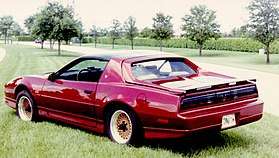
In 1988 the Trans Am GTA, which was built with the standard 350 cu in 5.7 L V8 engine, was offered with the option of removable roof "T-Tops". However, any buyer ordering this option could only order the 305 cu in 5.0 L V8 engine, because the roof would not have the support for all the extra torque from the engine, requiring a power trade-off for those who wanted this option. Pontiac also introduced a rare option for the Trans Am GTA in the 1988 model year. This notable option on the 1988 Trans Am GTA was the $800 "Notchback", which replaced the standard long large, glass-dominated hatchback to make the Firebird design look less like the Camaro design. The Notchback was a special fiberglass rear deck lid, replacing the long-sloped window with a short vertical rear window, resembling the back of a Ferrari 288 GTO.
Approximately 700 of these Notchbacks were built in 1988 and offered for sale by Pontiac. Promotion was only in the form of a sheet in the back of a notebook of available options. The Notchbacks were made by Auto-Fab of Auburn Hills, MI. Problems with incorrect fitting of the Notchbacks to the GTAs at the Van Nuys plant often resulted in delays of several months for buyers who wanted this option.[26] Furthermore, quality control problems plagued the Notchback, many owners complained of rippling and deforming of the fiberglass rear deck, and others complained of large defects resembling acne forming in the Notchbacks. Pontiac had to repair them under warranty, sanding down the imperfections, and repainting them, only to have more flaws resurface months later. Due to poor quality and numerous expensive warranty repairs and repainting, it was subsequently canceled on the 1989 20th Anniversary Turbo Trans Am, although a handful of them were still produced.
Engines
| 1982 | LQ9 2.5 L (151 cu in) GM EFI I4 90 hp (67 kW) | LC1 2.83 L (173 cu in) Chevrolet V6 102 hp (76 kW) | LG4 5.00 L (305 cu in) Chevrolet V8 145 hp (108 kW) | LU5 Crossfire EFI 5.0L Chevrolet V8 165 hp (123 kW) | ||
| 1983 | LQ9 2.5L GM EFI I4 92 hp (69 kW) | LC1 2.8L Chevrolet V6 107 hp (80 kW) | LL1 2.8L "HO" Chevrolet V6 125 hp (93 kW) | LG4 5.0L Chevrolet V8 150 hp (112 kW) | LU5 5.0L Chevrolet Crossfire EFI V8 175 hp (130 kW) | L69 5.0L "HO" Chevrolet V8 190 hp (142 kW) |
| 1984 | LQ9 2.5L GM EFI I4 92 hp (69 kW) | LC1 2.8L Chevrolet V6 125 hp (93 kW) | LL1 2.8L "HO" Chevrolet V6 125 hp (93 kW) | LG4 5.0L Chevrolet V8 150 hp (112 kW) | L69 5.0L "HO" Chevrolet V8 190 hp (142 kW) | |
| 1985 | LQ9 2.5L GM EFI I4 88 hp (66 kW) | LB8 2.8L Chevrolet EFI V6 135 hp (101 kW) | LG4 5.0L Chevrolet V8 155 hp (116 kW) | L69 5.0L "HO" Chevrolet V8 190 hp (142 kW) | LB9 5.0L Chevrolet tuned port injection V8 205 hp (153 kW) |
|
| 1986 | LQ9 2.5L GM EFI I4 88 hp (66 kW)(None Produced in '86) |
LB8 2.8L Chevrolet EFI V6 135 hp (101 kW) | LG4 5.0L Chevrolet V8 165 hp (123 kW) | L69 5.0L "HO" Chevrolet V8 190 hp (142 kW) | LB9 5.0L Chevrolet tuned port injection V8 190 hp (142 kW) | L98 5.7 L (350 cu in) Chevrolet tuned port injection V8 220 hp (164 kW) |
| 1987 | LB8 2.8L Chevrolet EFI V6 135 hp (101 kW) | LG4 5.0L Chevrolet V8 155 hp (116 kW) | LB9 5.0L Chevrolet tuned port injection V8, Automatic 190 hp (142 kW) | LB9 5.0L Chevrolet tuned port injection V8, Manual 215 hp (160 kW) |
L98 5.7L Chevrolet tuned port injection V8 225 hp (168 kW) | |
| 1988 | LB8 2.8L Chevrolet EFI V6 135 hp (101 kW) | LO3 5.0L Chevrolet V8 170 hp (127 kW) | LB9 5.0L Chevrolet tuned port injection V8, Automatic 195 hp (145 kW) | LB9 5.0L Chevrolet tuned port injection V8, Manual 220 hp (164 kW) |
L98 5.7L Chevrolet tuned port injection V8 230 hp (172 kW) | |
| 1989 | LB8 2.8L Chevrolet multi port fuel injection V6 135 hp (101 kW) | L03 5.0L Chevrolet throttle body injection V8 170 hp (127 kW) | LB9 5.0L Chevrolet tuned port injection V8,Automatic 195 hp (145 kW) | LB9 5.0L Chevrolet tuned port injection V8,Manual 220 hp (164 kW) |
LB9 5.0L Chevrolet tuned port injection V8,Manual w/Dual Cats N10 option 230 hp (172 kW) |
L98 5.7 L (350 cu in) Chevrolet tuned port injection V8 230 hp (172 kW) |
| 1989 (cont'd) | L98 5.7 L (350 cu in) Chevrolet tuned port injection V8 w/Dual Cats N10 Option 240 hp (180 kW) |
LC2 Buick 3.8L Turbocharged V6 250 hp (186 kW) |
Fourth generation (1993–2002)
| Fourth generation | |
|---|---|
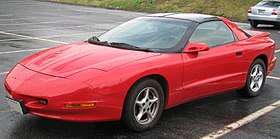 | |
| Overview | |
| Production | November 1992 – August 30, 2002[27] |
| Assembly | Sainte-Thérèse, Quebec |
| Body and chassis | |
| Body style | 2-door liftback 2-door convertible |
| Platform | F-body |
| Related | Chevrolet Camaro (fourth generation) |
| Powertrain | |
| Engine | 3.4 L (207.5 cu in) L32 V6 3.8 L (231.9 cu in) Buick V6 5.7 L (347.8 cu in) LT1 V8 5.7 L (347.8 cu in) LS1 V8 |
| Transmission | THM 4L60 4-speed automatic (1993) THM 4L60E 4-speed automatic (1994–2002) Borg Warner T-5 5-speed manual (V6 engine) Borg Warner T56 6-speed manual (V8 engine) |
| Dimensions | |
| Wheelbase | 101.1 in (2,568 mm) |
| Length | 1993–1997 Firebird: 195.6 in (4,968 mm) 1998–2002 Firebird: 193.3 in (4,910 mm) 1993–1997 Trans Am: 197 in (5,004 mm) 1998–1999 Trans Am: 193.8 in (4,923 mm) 2000–2002 Trans Am: 193.7 in (4,920 mm) |
| Width | 1993–1997: 74.5 in (1,892 mm) 1998–2002: 74.4 in (1,890 mm) |
| Height | 1993–1999 Firebird 52 in (1,321 mm) 2000–2002 Firebird: 51.2 in (1,300 mm) 1993–1995 Trans Am: 51.7 in (1,313 mm) 1996–1999 Trans Am: 52 in (1,321 mm) 2000–2002 Trans Am: 51.8 in (1,316 mm) 1993–1999 Firebird Convertible: 52.7 in (1,339 mm) 2000–2002 Firebird Convertible 51.8 in (1,316 mm) 1994–1999 Trans Am Convertible: 52.4 in (1,331 mm) |
| Curb weight | 3,440 lb (1,560 kg) (5.7L LT1 Coupe) 3,284 lb (1,490 kg) (5.7L LS1 Coupe) |
The fourth-generation Firebird amplified the aerodynamic styling initiated by the previous generation. While the live rear axle and floorpan aft of the front seats remained largely the same, ninety percent of the Firebird's parts were all-new.[28] Overall, the styling of the Firebird more strongly reflected the Banshee IV concept car than the 1991 "facelift" did. As with the Camaro, major improvements included standard dual airbags, four-wheel anti-lock brakes, 16-inch wheels, rack-and-pinion power steering, short/long-arm front suspension, and several non-rusting composite body panels. Throughout its fourth generation, trim levels included V6-powered Firebird, and V8-powered Formula and Trans Am. Standard manual transmissions were the T5 five-speed manual for the V6s, Borg-Warner's T56 six-speed manual for the V8s. The 4L60 four-speed automatic was optional for both in 1993, becoming the 4L60E with built-in electronic controls in 1994.
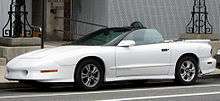
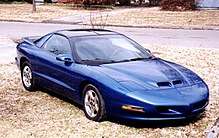
1993–1997
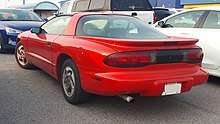
From 1993 until 1995 (1995 non-California cars), Firebirds received a 160 hp (119 kW) 3.4 L V6, an enhanced version of the third-generation's 3.1 L V6. Beginning mid-year 1995 onward, a Series II 3.8 L V6 with 200 hp (149 kW) became the Firebird's sole engine. From 1993 to 1997, the sole engine for the Formula and Trans Am was the 5.7 L LT1 V8, essentially identical to the LT1 in the C4 Corvette except for more flow-restrictive intake and exhaust systems. Steering wheel audio controls were included with optional uplevel cassette or compact disc stereo systems.
Beginning with 1994 model year cars, "Delco 2001"-series stereo systems replaced the previous Delco units.[29]:898 This revised series, also introduced for other Pontiac car lines, featured ergonomically-designed control panels with larger buttons and an optional seven-band graphic equalizer. Also in 1994, the fourth-generation convertible was available; every Firebird (and Camaro) convertible featured a glass rear window with a built-in electric defroster.
The 1995 models were the same as those of previous years, but traction control (ASR: acceleration slip regulation) was available for LT1 Firebirds, controlled by a switch on the console. The steering wheels in all Firebirds was also changed; their optional built-in audio controls were more closely grouped on each side. The "Trans Am GT" trim level was dropped from the lineup after its model year run in 1994. For 1995, all Trans Ams received 155-mph speedometers and Z-rated tires. 1995 was also the first year of the vented version of the Opti-Spark distributors on LT1 F-cars, addressing a common mechanical fault with the unit. The 'transmission perform' button was available only in the 1994 and 1995 Formula and Trans Am. This option was stopped for the 1996 and later models, but the unused connections remain available for 1996 and 1997 Formula and Trans Am. While 1995 cars still used the OBD-I (on-board diagnostic) computer system (the last year of any American car including the F-body to use OBD-I), a majority of them had OBD-II connector ports under the dash.
Firebird performance levels improved for 1996, with the establishment of the stronger 200-hp 3.8 L V6 as the new base engine, and the power rating of the LT1 increased to 285 for 1996, due to its new dual catalytic-converter exhaust system. 1996 was also the first model year of the OBD-II computer system. Optional performance enhancements were available for each Firebird trim level; the Y87 performance packages for V6s added mechanical features of the V8 setups, such as four-wheel disc brakes, faster-response steering, limited-slip rear differential, and dual tailpipes.[29]:904 For Formulas and Trans Ams, functional dual-inlet "Ram Air" hoods returned as part of the WS6 performance package. The optional package boosted rated horsepower from 285 to 305, and torque from 325 lb·ft to 335. Also included were 17" x 9" wheels with 275/40ZR17 tires, suspension improvements, oval dual tailpipe tips, and a WS6 badge. Bilstein shocks were a further option with the package.
The 1997 model year introduced standard air conditioning, daytime running lamps (utilizing the front turnsignal lamps), digital odometers, and optional 500-watt Monsoon cassette or compact disc stereo systems to all Firebird trim levels.[29]:907 For V6 Firebirds, a W68 sport appearance package was also introduced as a counterpart to the Camaro RS trim level. The WS6 "Ram Air" performance package was now also an option for the Formula and Trans Am convertibles, although these convertibles did not receive the 17-inch wheel-and-tire combination. There were 41 Formula convertibles and 463 Trans Am convertibles produced from 1996 to 1997 with the WS6 package.
1998–2002
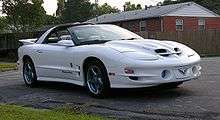
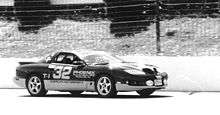
In 1997, in relation to the Camaro, the Firebird received a mid-cycle refresh for 1998 model year. Major changes included a new hood and front fascia with dual intakes, retracting quad halogen headlights, circular turnsignal and fog lamps, a front license plate pocket, lower fender air vents, unified-style lower door raised lettering for each trim level, and a new "honeycomb" rear light panel, with circular reverse lamps. In the dashboard, "next generation" reduced-force dual airbags became standard. As before, the Formula and Trans Am again received a close derivative of the Corvette's 5.7 L V8, the LS1 of the C5 Corvette, as the LT1 (and LT4) V8s were discontinued.[29]:911 The LS1 Firebirds were also equipped with an aluminum driveshaft, replacing the previous steel version, while all Firebird trim levels gained four-wheel disc brakes with dual-piston front calipers and larger rotors at each wheel, complete with a solenoid-based Bosch anti-lock system. The Formula convertible was no longer offered.
Beginning in 1998 for 1999 models, a standard 16.8-gallon non-metallic fuel tank increased potential traveling range. GM's ASR traction control system was extended to the V6-powered Firebirds, and all LS1 (V8) and Y87 (V6) Firebirds also received a Zexel/Torsen II slip-reduction rear axle. An electronic brakeforce distribution (EBD) system replaced the old hydraulic proportioning valve for improved brake performance. An enhanced sensing and diagnostic module (SDM) recorded vehicle speed, engine rpm, throttle position and brake use in the last five seconds prior to airbag deployment.[29]:915 In 1999, a Hurst shifter for variants with the 6-speed manual and a power steering cooler became options for LS1 Firebirds.
In 2000, the WS6 performance package was available exclusively for 2001 model year Trans Am coupe and convertible variants.
For 2002, more convenience items such as power mirrors and power antenna became standard equipment, while cassette stereos were phased out.
Special editions
Firehawk The special-edition extra-performance Firehawk (available in Formula trim for 1993–1997, and again in both Formula and Trans Am trims for 1999–2002) was produced by SLP Engineering, Inc., and sold through Pontiac dealerships. Featuring 17-inch wheels with namesake Firestone Firehawk 275/40ZR17 tires along with a functional twin-inlet hood above a specific air cleaner box, its rated power increased to 300 hp (224 kW) and 330 lb·ft (445 Nm) of torque. A total of 201 Firehawks were built for 1993. In 1994, the Firehawk package was expanded to include options for a suspension upgrade as well as a larger-diameter exhaust system that could boost power to 315 hp. T-top Formula coupes and convertibles could also be optioned as Firehawks beginning in 1995. For 1996 and 1997, the Firehawk gained rectangular driving lights mounted inside the front scoops and (except Firehawk convertibles) the Trans Am's elevated rear wing. In 1997, an LT4 Firehawk was also available, utilizing the same 330 hp, balanced-and-blueprinted LT4 V8 engine as found in the manual-transmission 1996 Corvette. A total of 29 LT4-powered Firehawks were produced.
Power levels for the 1999 Firehawk, powered by the LS1 V8, rose to 327 hp (330 in 2000, 335 in 2001, and 345 in late 2002 models equipped with the "Blackwing" intake). A 10th-anniversary Firehawk was available in 2001, distinguished as a black Trans Am coupe (123 units) and convertible (16 units) with gold-painted hood stripes (prototype only), gold vinyl stripes on hood and spoiler (production), gold 17-inch wheels, and gold tailpipe tips.
1994 Trans Am GT In 1994 only, a "Trans Am GT" option was available. Trans Am GTs did not receive any special badging, graphics, or emblems, and looked externally identical to the base Trans Am cars. The GT package included 245/50ZR16 tires and a 155-mph speedometer. Non-GT optioned Trans Ams in 1994 received 235/55R16 tires, a 115-mph speedometer, and a much lower top-speed limiter. The "highrise spoiler", leather, and T-tops were not standard on the Trans Am GT cars in 1994, nor any year of LT1 Trans Am. RPO code T43 "uplevel spoiler" was an option on all Trans Ams, and while the mass majority of 1994 Trans Am GT cars received the T43 spoiler (along with the majority of all 1993–'97 Trans Ams), it was not part of the Trans Am GT package. Both base Trans Ams and Trans am GTs could be ordered as coupe, T-top, or convertible versions and were both available with automatic or manual transmissions. While the GT package was a cost option on the 1994 Trans Am, a majority of 1994 Trans Ams were made with the GT package.
All of the 1994 Trans Am GT options became standard in 1995–2002 as part of the Trans Am package, and the GT name/package was dropped for 1995. Some of the early fourth-generation Trans Am and Formula Firebirds list "GT" on the vehicle's title or registration. The reason behind this is because the VIN does not specify a "package" (Formula, Trans Am, Trans Am GT, Firehawk, etc.); it only specifies the engine (5.7L V8 LT1). Because the title is based on the VIN alone, titles and registrations often list all of the packages, but it does not mean the car is equipped with any certain package.
1994 25th-Anniversary Trans Am The 1994 model year marked the 25th anniversary of the Trans Am, and another anniversary edition was released, painted white with a single dark blue stripe down the center of the vehicle that was reminiscent of the 1970 Trans Am. It also featured white-painted, five-spoke, 16-inch alloy wheels, and white leather seats and door trim. This edition was available in either coupe or convertible form.
1999 30th-Anniversary Trans Am As with the previous 25th-anniversary edition, the 30th-anniversary edition was either a white WS6 convertible or WS6 T-top coupe, with twin dark blue stripes from hood to tail, and distinct blue anodized five-spoke 17-inch alloy A-mold wheels, with white leather seats and door trim.
.jpg)
2001 was the 75th anniversary of Pontiac. An available 75th Anniversary Package incorporated a power and performance package that included power door locks including retained accessory power, power windows including express down drivers side, dual power sport mirrors, power antenna. Radio, ETR AM/FM stereo w/CD player and 7 band graphic equalizer inc clock seek up/down, remote cd pre-wiring Monsoon 500 watt peak power with 10 speaker premium sound system and steering wheel leather wrapped w/driver touch radio controls. Transmission; 4 speed auto. Power seat- drivers 6 way, Security package (includes theft deterrent system and remote key-less entry), 3800 performance package that included 3.42 gears with "posi-trac" Zexel Torsen T2 limited slip differential, 4 wheel disc brakes, dual mufflers and an LS1 steering rack= 14.4:1, 235/55/16 tires, ; hatch roof, removable, 16" chromed aluminum wheels, 50 state low emission vehicle. In 2001 the dealer price for this 75th Anniversary package was $4530.00. There were a total of 472 of these packages sold in 2001, #239 on the L36 Firebird, 231 on the Formula W66 Coupe, 5 on Formula Firehawks and 2 on Trans-Ams—making these editions quite rare.[30] Manufacturer original window stickers included this as a separate package listing the items and one price.
2002 Collector's Edition Trans Am For the Firebird's final year, a collector's edition Trans Am was released as either a yellow WS6 convertible or WS6 t-top coupe, with twin black stripes from hood to tail, black-painted five-spoke 17-inch alloy wheels, and further black-trimmed body details.
Engines
| 1993 | 3.4 L (207.5 cu in) L32 V6 | 5.7L 350 CID LT1 V8 (iron block, aluminum heads) | |
| 1994 | 3.4 L (207.5 cu in) L32 V6 | 5.7L 350 CID LT1 V8 (iron block, aluminum heads) | |
| 1995 | 3.4 L (207.5 cu in) L32 V6 | 3.8 L (231.9 cu in) L36 V6 (California Only) | 5.7L 350 CID LT1 V8 (iron block, aluminum heads) |
| 1996 | 3.8 L (231.9 cu in) L36 V6 | 5.7L 350 CID LT1 V8 (iron block, aluminum heads) | |
| 1997 | 3.8 L (231.9 cu in) L36 V6 | 5.7L 350 CID LT1 V8 (iron block, aluminum heads) | 5.7L 350 CID LT4 V8 (iron block, aluminum heads) in Firehawk by SLP |
| 1998 | 3.8 L (231.9 cu in) L36 V6 | 5.7L 346 CID LS1 V8 (aluminum block and heads) | |
| 1999 | 3.8 L (231.9 cu in) L36 V6 | 5.7L 346 CID LS1 V8 (aluminum block and heads) | |
| 2000 | 3.8 L (231.9 cu in) L36 V6 | 5.7L 346 CID LS1 V8 (aluminum block and heads) | |
| 2001 | 3.8 L (231.9 cu in) L36 V6 | 5.7L 346 CID LS1 V8 (aluminum block and heads) | |
| 2002 | 3.8 L (231.9 cu in) L36 V6 | 5.7L 346 CID LS1 V8 (aluminum block and heads) |
Firebird Trans Am
| Pontiac Firebird Trans Am | |
|---|---|
| Overview | |
| Manufacturer | General Motors |
| Production | 1969–2002 |
| Body and chassis | |
| Class | Pony car, Muscle car |
| Body style | 2-door convertible 1969, 1987–1989 Pontiac sanctioned special edition, 1991–1992, 1994–2002 2-door coupe 1969–2002 |
| Layout | FR layout |
| Platform | F-body |
.jpg)

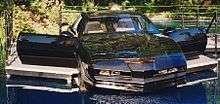
The Trans Am was a specialty package for the Firebird, typically upgrading handling, suspension, and horsepower, as well as minor appearance modifications such as exclusive hoods, spoilers, fog lights and wheels. Four distinct generations were produced between 1969 and 2002. These cars were built on the F-body platform, which was also shared by the Chevrolet Camaro.
Despite its name, the Trans Am was not initially used in the Trans Am Series, as its smallest engine exceeded the SCCA's five liter displacement limit.
The second generation was available from 1970 to 1981 and was featured in the 1977 movie Smokey and the Bandit, the 1978 movie Hooper, the 1979 movie Rocky II, and the 1980 movie Smokey and the Bandit II. The Firebird Trans Am was also selected as the Official Pace Car for the 1980 Indianapolis 500. The third generation, available from 1982 to 1992, was featured in the 1983 movie Smokey and the Bandit Part 3 and the 1984 movie Alphabet City. KITT, the automotive star, and its evil twin counterpart KARR, of the popular 1980s TV series Knight Rider, was a modified third-generation Trans Am. The fourth-generation Trans Am, available from model years 1993 to 2002, offered between 275 and 325 bhp (205 and 242 kW). The fictional character Dwight Schrute from NBC's show The Office, is another famous driver of the 1987 model.
The Trans Am GTA (Gran Turismo Americano) was an options package available on the Firebird Trans Am which added gold 16-inch diamond-spoke alloy wheels, a mono-chromatic paint scheme and special cloisonné GTA badges. The GTA (along with the Formula model that was intended to fill the gap between the base model Firebird and mid-level Trans Am) was the brainchild of former Pontiac marketing manager Lou Wassel. It was intended to be the "ultimate" Trans Am and was the most expensive Firebird available. The GTA equipment package officially went on sale in 1987 and avoided a gas-guzzler tax thanks to its lightweight PW 16-inch gold cross-lace wheels. The high-performance WS6 suspension package was also re-tuned to offer a more compliant ride while still maintaining tight handling characteristics. Engine choices consisted of a L98 5.7 liter (350 ci) TPI V8 mated to GM's corporate 700R4 automatic transmission or the 5.0 liter (305 ci) TPI V8. A five-speed manual was available but was mated to the 5.0 liter only. The GTA trim level was available from 1987 through the 1992 model year.
For 1989, the 20th anniversary turbo Trans Am project (originally conceived by Bill Owen of Pontiac) was outsourced to PAS, Inc., an engineering firm led by Jeff Beitzel. Beitzel and his team did most of the TTA development work. The 3.8 liter turbocharged V6 engines were built by PAS at their 40,000 square foot City of Industry, CA plant. From there, they went to GM's plant in Van Nuys, CA to be installed into GTAs on the F-Body assembly line. The cars were then shipped back to PAS for final assembly, testing, and quality control. Incidentally, the GTA chassis were selected at random, thus there is no correlation between the VIN and production sequence number. The initial number of cars to be produced had ranged from 500 to 2,500 until GM finally settled on 1,500. In all, a total of 1,555 Turbo Trans Ams were manufactured. One of these served as the 1989 Indianapolis 500 pace car.
The 2002 model-year WS6 Trans Am produced 325 hp (242 kW) at 5,200 rpm and 350 lb⋅ft (475 N⋅m) of torque at 4,000 rpm out of its 5.7-liter LS1 V8 engine.[31] A completely-stock WS6 completed the ¼—mile in 13.16 seconds at 106.05 mph on Eagle F1 street tires.[32]
Engines
First generation
| 1969 | 400 cu in (6.6 L) Pontiac Ram Air III V8 335 bhp (250 kW) | 400 cu in (6.6 L) Pontiac Ram Air IV V8 345 bhp (257 kW) | 400 cu in (6.6 L) Pontiac Ram Air V V8 (rare dealer-installed option) 500 bhp (373 kW) |
Second generation
| 1970 | 400 cu in (6.6 L) Pontiac Ram Air III 345hp V8 | 400 cu in (6.6 L) Pontiac Ram Air IV 370hp V8 | 400 cu in (6.6 L) Pontiac Ram Air V V8 There are no known 1970 Trans Ams with the Ram Air V, no complete engines were ever sold or shipped to dealers, but the parts needed to build one could be ordered over-the-counter.[33] |
| 1971 | 455 cu in (7.5 L) Pontiac H.O. V8 | ||
| 1972 | 455 cu in (7.5 L) Pontiac H.O. V8 | ||
| 1973 | 455 cu in (7.5 L) Pontiac V8 | 455 cu in (7.5 L) Pontiac S.D. V8 | |
| 1974 | 400 cu in (6.6 L) Pontiac V8 | 455 cu in (7.5 L) Pontiac V8 | 455 cu in (7.5 L) Pontiac S.D. V8 |
| 1975 | 400 cu in (6.6 L) Pontiac V8 | 455 cu in (7.5 L) Pontiac V8 455-H.O. These cars came with a 455-H.O decal on the Shaker Hood Scoop but were not anywhere near the same engine as the 71–72 H.O.'s. They were standard production engines lifted from Pontiac's station wagon line and transplanted straight into the T/A. Rated at ~ 200 HP. Pontiac did this to try to boost sales, and the engine was only available with the 4-speed manual transmission. A total of 857 were built as it was a mid-year addition.[34] | |
| 1976 | 400 cu in (6.6 L) Pontiac V8 | 455 cu in (7.5 L) Pontiac V8 455 H.O. The only difference between this engine and the previous 1975 engine is the H.O. was removed from the shaker hood scoop and simply said 455. It came with a 4-speed manual transmission. A total of 7,099 were built this year's full production run.[35] | |
| 1977 | 403 cu in (6.6 L) Oldsmobile V8 | 400 cu in (6.6 L) Pontiac W72 V8 | |
| 1978 | 403 cu in (6.6 L) Oldsmobile V8 | 400 cu in (6.6 L) Pontiac W72 V8 | |
| 1979 | 301 cu in (4.9 L) Pontiac V8 | 403 cu in (6.6 L) Oldsmobile V8 (Automatic only) | 400 cu in (6.6 L) Pontiac W72 V8 (4-speed only)These engines were actually 1978s that were stockpiled for 1979. Pontiac ceased production of the 400 in 1978. |
| 1980 | 301 cu in (4.9 L) Pontiac V8 | 305 cu in (5.0 L) Chevrolet V8 | 301 cu in (4.9 L) Pontiac turbo V8 |
| 1981 | 301 cu in (4.9 L) Pontiac V8 | 305 cu in (5.0 L) Chevrolet V8 (4-speed only) | 301 cu in (4.9 L) Pontiac turbo V8 |
Third generation
From 1982 onward, all engines were Chevrolet sourced, unless stated otherwise.
| 1982 | 305 cu in (5.0 L) 4 barrel V8 | 305 cu in (5.0 L) cross-fire injection V8 (First year for fuel injection in Trans Am) | ||
| 1983 | 305 cu in (5.0 L) 4 barrel V8 | 305 cu in (5.0 L) cross-fire injection V8 | 305 cu in (5.0 L) 4 barrel V8 H.O. (662 were made, all 5-speeds) | |
| 1984 | 305 cu in (5.0 L) 4 barrel V8 | 305 cu in (5.0 L) 4 barrel H.O. V8 (1500 anniversary edition models were made, 500 of them 5-speed) | ||
| 1985 | 305 cu in (5.0 L) 4 barrel V8 | 305 cu in (5.0 L) tuned port injection V8 | 305 cu in (5.0 L) 4 barrel H.O. V8 H.O. (5-speed only) | |
| 1986 | 305 cu in (5.0 L) 4 barrel V8 | 305 cu in (5.0 L) tuned port injection V8 | 305 cu in (5.0 L) 4 barrel V8 H.O. (5-speed only) A total of 69 were built. | |
| 1987 | 305 cu in (5.0 L) 4 barrel V8 | 305 cu in (5.0 L) tuned port injection V8 | 350 cu in (5.7 L) tuned port injection V8 | |
| 1988 | 305 cu in (5.0 L) throttle body injection V8 | 305 cu in (5.0 L) tuned port injection V8 | 350 cu in (5.7 L) tuned port injection V8 | |
| 1989 | 305 cu in (5.0 L) throttle body injection V8 | 305 cu in (5.0 L) tuned port injection V8 | 350 cu in (5.7 L) tuned port injection V8 | 231 cu in (3.8 L) Buick Turbo V6 |
| 1990 | 305 cu in (5.0 L) throttle body injection V8 | 305 cu in (5.0 L) tuned port injection V8 | 350 cu in (5.7 L) tuned port injection V8 | |
| 1991 | 305 cu in (5.0 L) throttle body injection V8 | 305 cu in (5.0 L) tuned port injection V8 | 350 cu in (5.7 L) tuned port injection V8 | |
| 1992 | 305 cu in (5.0 L) throttle body injection V8 | 305 cu in (5.0 L) tuned port injection V8 | 350 cu in (5.7 L) tuned port injection V8 |
Post–Pontiac Trans Am
.jpg)
In 2012, General Motors signed a licensing deal with Trans Am Depot to use the Trans Am name and Pontiac logos in custom versions of new Trans Am.[36] Under this agreement, Trans Am Depot takes brand-new model Chevrolet Camaros, strips them down to their basic components and rebuilds what looks like new Trans Am.[37] They make these in the designs of the 6T9 version Trans Am, 6T9 Goat ("GTO"),[38][39] 7T7 Trans Am and the limited-edition Hurst Trans Am.[40][41]
On March 26, 2017, at the New York International Auto Show, the Bandit Edition Trans Am was introduced. Built by Trans Am Depot, only 77 will be produced, each signed by Burt Reynolds.[42][43] Powertrain is a 455 cu in (7.5 L) direct injection version of the current Generation V LT1 V8 engine equipped with a 2.3 litres (140.4 cu in) Magnuson supercharger with a boost of 14 psi (0.97 bar), developing 1,000 hp (746 kW) and 1,046 lb⋅ft (1,418 N⋅m) of torque.[44][43]
Burt Reynolds collection of Firebirds
On April 14, 2018 at the Barrett-Jackson collector car auction in Palm Beach, FL, just 5 months before his death, actor Burt Reynolds presided over the sale of 3 Pontiac Firebird Trans Ams from his personal collection, sold via Bandit Movie Cars of Florida, the custodian of the Burt Reynolds collection. He was also an avid Firebird collector after filming the movies Hooper and also the Smokey and the Bandit movie series. The first car was a red 1977 Firebird Trans Am survivor car from the Restore a Muscle Car Collection with a price of $57,200. The second vehicle was a rare 1974 Pontiac Trans AM 455 Super Duty, which was another survivor that reached $100,000 plus 10% buyer commission. The third car Reynolds sold was a 1980 Indianapolis pace car turbo Trans Am, which was also $100,000, plus 10% buyer commission.[45]
Performance (Firebird / Firebird Trans Am)
| Engine | Year(s) | Power | 0–60 mph (0–97 km/h) | Top speed | Comments |
|---|---|---|---|---|---|
| 400 cu in (6.6 L) Pontiac W72 V8 | 1979 | 220 bhp (164 kW) | > 132 mph (212 km/h) | Trans Am model equipped with 400 4-speed manual[46] | |
| 305 cu in (5.0 L) LB9 V8 | 1989–1992 | 225 bhp (168 kW) | > 140 mph (225 km/h) | Formula model equipped with N10/MM5/GM3 option codes[47] | |
| 350 cu in (5.7 L) L98 V8 | 1987–1992 | 235 bhp (175 kW) | > 145 mph (233 km/h) | GTA model | |
| 231 cu in (3.8 L) Buick Turbo V6 | 1989 | 250 bhp (186 kW) | 162 mph (261 km/h)[49] | 20th anniversary Trans Am pace car | |
| 5.7 L (347.8 cu in) LT1 V8 | 1993–1997 | 275–285 bhp (205–213 kW) | 155 mph (249 km/h) (electronically limited) | ||
| 1996–1997 | 305 bhp (227 kW) | 155 mph (249 km/h) (electronically limited) | Ram Air | ||
| 5.7 L (345.7 cu in) LS1 V8 | 1998–2000 | 320 bhp (239 kW) | 160 mph (257 km/h) (electronically limited) | ||
| 2001–2002 | 325 bhp (242 kW) | 160 mph (257 km/h) (electronically limited) |
Racing
Firebirds were used in the Trans-Am series in the 1960s and 1970s. When the Firebird Trans Am was released, there was controversy over the model's inability to compete in the Trans-Am because the smallest available engine was too large for use in the series at 400 cubic inches (6.6 liters). The name also caused controversy because it was used without permission from the SCCA, who threatened suit. GM settled the dispute by paying $5 to the SCCA for each car they sold. When the Trans-Am was last seen, model year 2002 Firebirds were in use. From 1996 to 2006, a WS6 Trans Am coupe provided the body style for the mechanically identical racing cars used in the International Race of Champions (IROC).
During the 1995, 1996, and 1997 NHRA seasons, 14-time funny car champion John Force used a Firebird body to replace the obsolete Oldsmobile Cutlass and Chevrolet Lumina bodies he had used since 1988. He used it for three seasons, winning the championship in all three years. The Firebird was also used by drivers such as Del Worsham, Tim Wilkerson, Frank Pedregon, and Jerry Toliver. The Firebird body also replaced the Oldsmobile Cutlass in the pro stock class in 1995, forcing drivers Warren Johnson, Jerry Eckman, and Mark Pawuk to replace their body styles for the 1996 year. None of them would win with the first year of the Firebird body, but pro stock driver Jim Yates, a second year driver, using the Firebird body, did.
Notes
- On March 1, 1968, the L67 400CID Ram Air engine was deleted as an option and replaced with the same named L67 400CID Ram Air II engine. The new L67 was rated at 340 hp (250 kW), with revised cylinder heads that included round exhaust ports. The pistons and crankshaft were of forged construction and it included a higher lift cam with a more durable valvetrain.[1]
- Chevrolet 350, VIN code "L", Buick 350, VIN code "X", and Oldsmobile 350, VIN code "R", enigines were all used.[1]
- In 1971, General Motors changed from posting brake horsepower, which is measured at the engine, to net horsepower, measured at the wheels.[1]
- The lower rating is for a car equipped with an automatic transmissions, the higher rating is for a car equipped with a manual transmission.[1]
- Early engines were rated at 310hp but due to internal changes, primarily with the camshaft, the rating was dropped to 290hp, these changes were made to meet emissions standards.[1]
- The 170hp engine was standard on the Esprit and Formula models.[1]
- Indroduced midyear.[1]
- In 1978 GM switched to referencing their engince displacement in metric terms.[1]
References
- Sessler, Peter C. (1992). Firebird Red Book – Pontiac Firebird from 1967. Osceola, Wisconsin: Motorbooks International. ISBN 0879385685.CS1 maint: ref=harv (link)
- "1967 Cougar". Muscle Car Facts. Archived from the original on 10 June 2015. Retrieved 10 June 2015.
- Montievo, Andrew (2 June 2015). "How the Mercury Cougar shaped today's luxury cars". Tech Gen Magazine.
- "1967 Pontiac Firebird Sprint Technical Specifications". Carfolio.com. Retrieved November 29, 2011.
- Kowalke, Ron (26 May 2010). "The Six-cylinder Firebird Sprint: Slouch or sleeper?". F+W. Old Cars Weekly.
- "Pontiac Firebird Trans Am, 1970 MY 2887". Carfolio.com. 2014-05-01. Retrieved August 6, 2018.
- Pontiac Firebird History 1st Generation 1967–1969 by Muscle Car Club, undated Archived 2008-09-14 at the Wayback Machine, retrieved on August 22, 2008.
- Hemmings motor news Terry Shea July 2013
- Gunnell, John A. (1998). Illustrated Buyer's Guide, Firebird – 3rd. Ed. MBI Publishing Company. ISBN 0-7603-0602-8.
- "Hitman's Pontiac Trans Am Site". 78ta.com. Archived from the original on December 4, 2010. Retrieved October 3, 2010.
- Editors of Publications International (December 21, 2007). "1970s Pontiac Firebird". auto.howstuffworks.com. Retrieved February 27, 2011.CS1 maint: extra text: authors list (link)
- "Hitman's Pontiac Trans Am Site – Special Edition". 78ta.com. Archived from the original on September 25, 2010. Retrieved October 3, 2010.
- "Mecham Design Performance". mechamperformance.com. Retrieved April 18, 2012.
- Flory, J. Kelly (2004). American Cars, 1960–1972: Every Model, Year by Year. McFarland. p. 881. ISBN 978-0-7864-1273-0.
- "Hot Rod: Pontiac save best muscle car last". hotrod.com. Retrieved June 23, 2018.
- Super Stock and Drag Illustrated June 1974
- Flory Jr., J. Kelly (2012). American Cars, 1973–1980: Every Model, Year by Year. McFarland. p. 530. ISBN 9780786443529. Retrieved 2 December 2017.
- Newhardt, David. Firebird Trans Am. MotorBooks International. p. 57. ISBN 9781610609289. Retrieved 2 December 2017.
- Adolphus, David Traver (August 2011), "1977–'78 Pontiac Firebird Formula", Buyer's Guide from Hemmings Muscle Machines, American City Business Journals
- Peters, Eric (2004). Automotive Atrocities: Cars You Love to Hate. p. 20. ISBN 9780760317877.
- "1980-1981 Pontiac Trans Am Turbo 4.9L V8 - It's Better Than You Think". 2018-01-31.
- "1980 Pontiac Firebird Trans Am".
- "TRANSAM.ME - the Best Place for all TRANSAM Lovers".
- fueleconomy.gov "Find a Car; 1982, 1983, 1984, 1985 Firebird 2.5 L 5-speed fuel economy Official EPA Window Sticker MPG" Web. July 4, 2010
- Gunnell, John (2002). standard catalog of Firebird 1967–2002. Iola, WI: krause publications. pp. 97–118. ISBN 0-87349-494-6.
- "1988 Trans Am GTA Notchback – Hatch-22 – High Performance Pontiac". Hot Rod Network. 2008-09-01. Retrieved 2019-02-22.
- Staff of Old Cars (2010). Camaro & Firebird – GM's Power Twins. Krause Publications. ISBN 978-1440217524. Retrieved 2 December 2017.
- Road & Track Special Series: Guide to the All-New 1993 Pontiac Firebird. Hachette Magazines, Inc. 1992. pp. 2–3.
- Flammang, James; Kowalke, Ron (1999). standard catalog of American Cars 1976–1999 (third ed.). Krause. ISBN 0-87341-755-0.
- "4th Gen Firebird Breakdown Numbers". Trans Am World. Retrieved July 23, 2017.
- 2002 Pontiac FIREBIRD-V8-6 Spd./AT Coupe 2D Trans Am WS6 – NADAGuides
- "Archived copy". Archived from the original on 2014-05-27. Retrieved 2014-05-27.CS1 maint: archived copy as title (link) Stock 2002 Trans Am WS6 at the track – StreetFire
- "Pontiac Ram Air V Story". Wallace Racing. Retrieved October 21, 2015.
- "1975 Pontiac Firebird Trans Am". 2gta.com. Retrieved October 21, 2015.
- "The 1976 Pontiac Firebird Trans Am". 2gta.com. Retrieved October 21, 2015.
- Luft, Alex (March 16, 2013). "TransAm Depot Gives Camaro The Pontiac Treatment". GM Authority. Retrieved October 20, 2015.
- Kaowthumrong, Patricia (January 8, 2013). "Flying High". Performance HotRod Business. Archived from the original on July 22, 2015. Retrieved October 20, 2015.
- LINGEMAN, JAKE (24 Jun 2013). "GTO Judge poised for a comeback". Crain Communications. Autoweek.
- Justin, Cesler (December 12, 2013). "Here Comes the Judge". High Performance Pontiac Magazine. Archived from the original on July 21, 2015. Retrieved October 20, 2015.
- "Hurst Edition Trans Am". trans am depot. Retrieved October 20, 2015.
- Ross, Jeffrey (May 13, 2013). "2013 Hurst Edition Trans Am". AutoBlog. Retrieved October 20, 2015.
- "The Trans Am Bandit Edition Unveiled!". Transamworldwide.com. Retrieved 2018-11-04.
- Jason Udy, ed. (2017-04-13). "1000-HP 2017 Trans Am 455 Super Duty bows in New York". Motortrend.com. Retrieved 2018-11-04.
- "Trans Am 455 Super Duty Specs" (PDF). Transamworldwide.com. Retrieved 2018-11-04.
- "Burt Reynolds adds fuel to the fire at record Barrett-Jackson Palm Beach Auto Auction". www.carbuyingtips.com. Retrieved 2019-02-20.
- Hot Rod magazine 1979.
- "Road Test". Car and Driver. 35 (9). March 1990.
- "1989 20th Anniversary Trans Am Road Test, CAR & DRIVER Magazine, June 1989". Gtasourcepage.com. 2001. Retrieved October 21, 2015.
- "Flat-out Fastest American Cars II-the Sequel". Motor Trend. 41 (6): 42–47, 50, 54. June 1989.
- "2000 Pontiac Firebird Trans Am WS6 - First Drive & Road Test Review - Motor Trend". 2003-12-12.
- "Pontiac 0-60 Times & Pontiac Quarter Mile Times | Pontiac GTO, G8, Trans Am, Grand Am, Fiero & more 0 to 60 stats!".
External links
| Wikimedia Commons has media related to Pontiac Firebird. |
- Firebird Heritage official Pontiac site
- Trans Am world wide
- Pontiac Firebird at Curlie
- Pontiac Firebird and Pontiac Trans Am at The Crittenden Automotive Library
- The Fire Chicken restoration project of 1987 Firebird